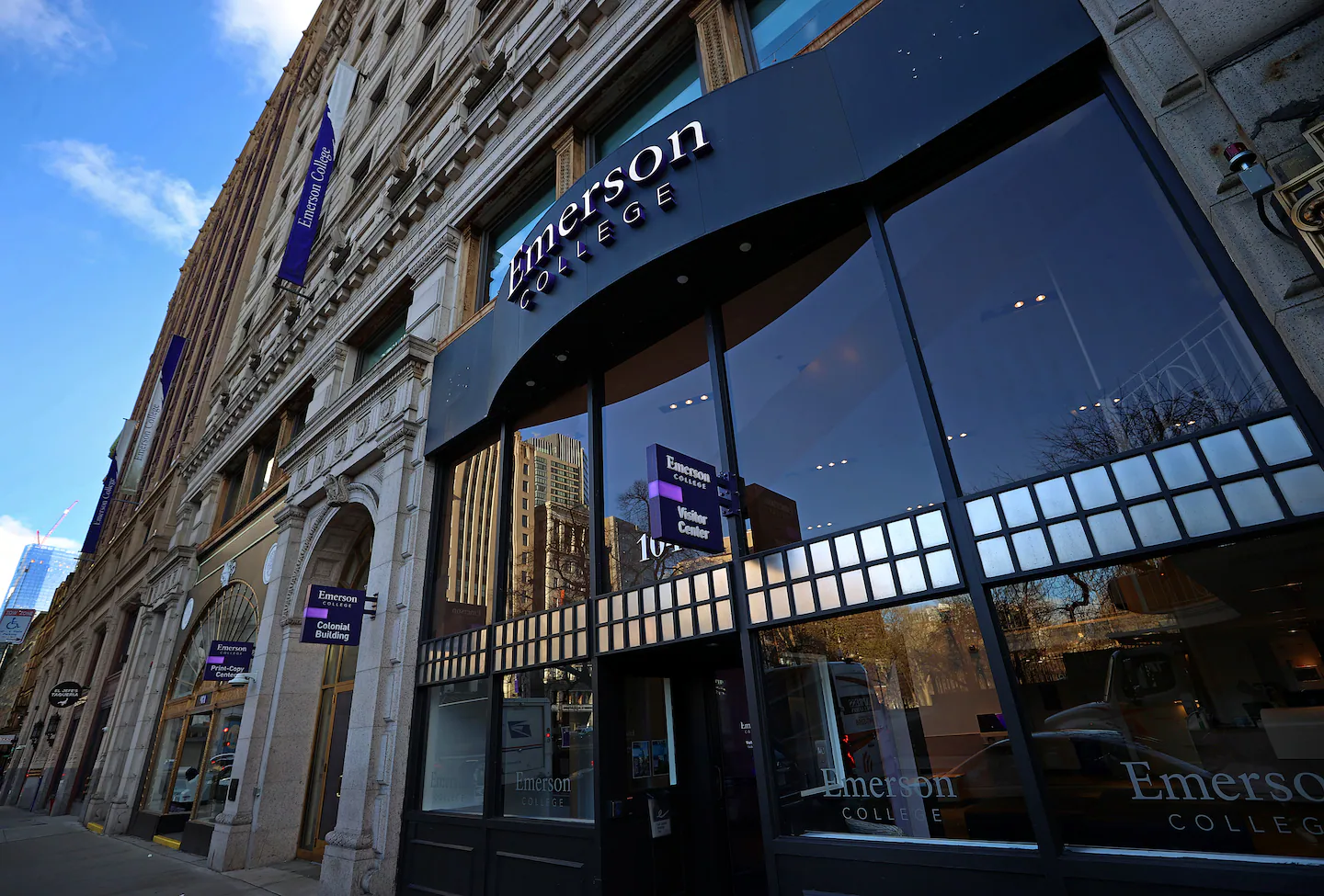
The arts and communication college is facing the same financial challenges as small schools across the country. Slumping enrollment, mushrooming costs, and upheaval in federal higher education policy are driving more universities into the red. At Emerson, those problems are coming to a head alongside a fiery debate on campus about what the college stands for as higher education is under political attack.
Last fall, enrollment at Emerson fell by 6 percent. Tuition and housing revenue from its 3,000-some students is down by around $16 million, administrators recently told faculty. Not only has the college eliminated staff positions, it’s offering early retirement and buyouts to some professors.
In the year and a half since the 118 protest arrests cast a pall on campus, complaints abound that Emerson has strayed from its progressive values while under federal investigation for allowing antisemitism.
Now one of the most queer, most liberal, and most civically engaged campuses in the country has decided to stop taking public political stances and removed “equity” and “social justice” from the name of its inclusion offices. A new policy that requires campus demonstrations to be pre-registered is seen by some as a suppression of free speech. And the repeated removal of the student newspaper from some buildings has unnerved the journalism faculty, said Paul Niwa, a tenured professor and a former member of the college president’s advisory committee.
“What [Emerson] did tactically was to discourage any discussion,” Niwa said. “By stifling the conversation, it just created more extreme positions, more rumors, more bad will. It created the worst-case situation for the college.”
An Emerson spokesperson said it put “absolutely no limits” on distribution of The Berkeley Beacon. (Diti Kohli, a Globe reporter who wrote this story, is a volunteer adviser to the student paper.)
Emerson president Jay Bernhardt is charting a path forward that builds on the college’s downtown location and its key strength, vocationally focused degrees with a liberal arts bent. It has spun its successful film department into its own school within the institution, and almost a dozen new faces have joined its board of trustees.
“You can’t cut into the bone,” Bernhardt said. ”When you’re going to make strategic cuts or realignments, you have to balance what you can afford to reduce with areas you need to grow.”
“This is a really big opportunity for Emerson to leapfrog many other colleges on how we position ourselves.”
Not everyone agrees.
Emerson has reinvented itself before. In the 1990s, the school dug itself out of a financial hole, moved from Back Bay to the Theater District, and expanded enrollment by as much as 50 percent. It climbed the national rankings and added nearly three dozen professors between 2013 and 2019. That year, its leadership felt confident enough to absorb another struggling school, Marlboro College in Vermont.
Then came a collision of bad luck and poor planning.
Emerson lost $30 million in 2021 and spent two years without a permanent president. That slowed the school’s progress, said John Rodzvilla, president of the full-time faculty union. “We’ve only had one year to get the college moving the way it was before 2020.”
Bernhardt’s arrival from the University of Texas in 2023 was quickly followed by the hiring of several new administrators and qualms about the pricey condominium purchased for his residence. When 12 students protesting tuition hikes and the war in Gaza outside his inauguration were arrested, it planted seeds of doubt about Bernhardt that, for some, only metastasized over time.
In fall 2024, Emerson’s admission rate topped 50 percent for the first time in at least a decade, and college leaders blamed the enrollment decline partly on “negative press.”
Its substantial debt, upward of $400 million, is a frequent point against the institution in credit reports, where Moody’s noted that its “financial leverage … is outsized compared to its budget.”
And despite stronger investment returns on its roughly $300 million endowment, Emerson is bracing for fewer tuition dollars from fewer students, the source of nearly all its revenue, even as it doles out more financial aid.
In response, Emerson trimmed around the edges. It last year eliminated a popular film screening series and civic participation research lab, laying off 10 people. This summer brought staff cuts everywhere from the library to the college radio station.
It all trickles down to the students, a half dozen people told the Globe.
The two remaining employees in the theater costume shop cannot manage the clothes for student productions while still teaching. Fewer part-time journalism faculty were called back for classes this semester, four professors in the department said. And the team responsible for making online course content ADA complaint is down to three people from seven, said staff union steward Illona Yosefov.
Colleges across the region are eliminating degrees, terminating staff, and grappling with potential declines in international and graduate students. But some critics said Emerson’s problems stem from its own short-sightedness.
The school last year shut down its pre-college program for interested high school students to spend a few weeks on campus in the summer. It provided both steady revenue and a conduit to hundreds of undergraduate applicants, said its founder and Emerson alumna Tori Weston.
“The minute you don’t run a pre-college program, you are signaling to other schools that there is something wrong at the college,” said Weston, who now works at Boston College.
And acquiring Marlboro turned into a drain at least by some measures. The Vermont college’s57 transfer students were paying lower tuition than Emerson charges, and the college now has several Marlboro faculty on the payroll indefinitely. The liberal arts expertise Marlboro brought is also a “shrinking market” and possibly a poor investment for Emerson, said Peter Stokos, a higher education expert with Huron Consulting Group.
An Emerson spokesperson said the pre-college program, closed due to staffing departures, will relaunch next year and that the college benefitted from Marlboro’s roughly $25 million endowment in the merger.
Emerson is recently making moves to shore up its finances. In January, it sold $88 million in bonds to refinance long-term debt and froze salary increases for its highest-paid administrators. It took in students from the Boston Architectural College and the Wentworth Institute of Technology to fill otherwise empty dorm space. Better yet, Moody’s reported last year, donations from Emerson alumni are up.
In August, longtime Emerson communications professor Gregory Payne peppered his Instagram with pictures of Bernhardt shuffling around during move-in, greeting students, smiling.
“I feel very good about where the college is,” Payne said. “Over the summer, there’s a bit of a new mood. We’ve learned on how we can do things better. We have to put our boots on and get through this.”
But ask Bernhardt’s critics, and they’ll say he’s rarely seen out and about on campus.
After the protest crackdown, student government leaders voted no confidence in his leadership. And some perceive the school as an uncharacteristically restrictive environment today.
Administrators tightened access to executive offices on the 14th floor of the Ansin Building on Tremont Street. Two resident assistants were fired last year for allegedly supporting campus protests, the student paper reported, as was a former employee whose wrongful termination case is still in litigation.
Emerson said it does not have special security measures on the 14th floor and “unequivocally denies any allegation of wrongdoing or retaliation” related to the departures.
This fall, the college also made its student of color pre-orientation programming available to everyone, a move that Emerson junior Melody Rivas interpreted as effectively canceling it.
“It felt like the [disciplinary] rules were changing constantly,” she said. “It feels like there is no administrative support.”
Isaac Kamola, a Trinity College professor and director of the AAUP Center for the Defense of Academic Freedom, said he has spoken to Emerson academic staff who have called on leadership to more staunchly protect free expression in and out of the classroom.
“Academic freedom is a muscle. You have to have your principles and standards, and you have to be willing to exercise them,” he said. “When push comes to shove, Emerson’s administration has shown … they don’t have the muscle, the training, the expertise, or courage to defend it.”
Bernhardt said the culture at Emerson “hasn’t changed” in his tenure, during which the college took steps to address incidents of antisemitism, support Jewish students, and encourage campus discussions.
The goal now? Tackling Emerson’s financial challenges, while mending fences between students, faculty, and the administration.
The challenge lies in getting everyone on the same page, said Shaun Clarke, interim dean of the School of Film.
”Everyone that I know at the college loves the college, but people have different strategies or different outlooks on how to address the challenges that we have,” Clarke said. “I don’t know if it’s two camps. There might be 20 camps. Or 250 camps. But eventually, we have to get it down to one.”



